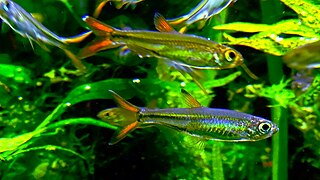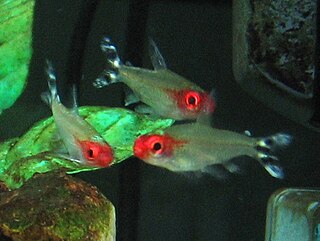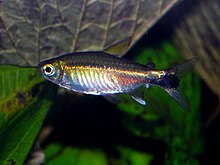
The black neon tetra is a freshwater fish of the characin family (Characidae) of the order Characiformes. It is native to the Paraguay basin of southern Brazil. They are often found in the aquarium trade.

Thayeria boehlkei is a species of characin fish endemic to the Amazon River basin and Araguaia River, in Peru and Brazil respectively. The species is popular with aquarium hobbyists where it is traded under a variety of common names including blackline penguinfish, blackline thayeria, hockey-stick tetra, penguin fish and penguin tetra.
George Sprague Myers was an American ichthyologist who spent most of his career at Stanford University. He served as the editor of Stanford Ichthyological Bulletin as well as president of the American Society of Ichthyologists and Herpetologists. Myers was also head of the Division of Fishes at the United States National Museum, and held a position as an ichthyologist for the United States Fish and Wildlife Service. He was also an advisor in fisheries and ichthyology to the Brazilian Government.

The ember tetra is a freshwater fish of the characin family of order Characiformes. It is native to the Araguaia River basin of Brazil and was discovered in 1987 and named in honor of the fish explorer Heiko Bleher's mother.

Nematobrycon palmeri, commonly known as the emperor tetra, is a species of characid fish found in the Atrato and San Juan river basins in western Colombia. It was first imported in the aquarium trade to the United States in 1960 and has since become well established.

Myloplus schomburgkii, also known as the Disk tetra, Disk pacu, Black-ear pacu, Black-band myleus or Black-barred myleus is a species of serrasalmid with a black bar on its side. This species is found in the middle and lower Amazon River basin, Nanay River, upper Orinoco River basin in Brazil, Peru, Venezuela and possibly in Suriname.

Ladigesia roloffi, the Sierra Leone dwarf characin, is a species of harmless African tetra that is found in Sierra Leone and Liberia, Africa. L. roloffi is the only member of its genus. The fish was named in honor of German aquarist Erhard Roloff (1903–1980), who collected the type specimen. They are a social species generally living in schools at mid depths and surface level fresh water. It lives for five years. Ninety-seven percent of their natural habitat has been lost.

The royal tetra is a species of characin endemic to Brazil, where it is found in tributaries of the Aripuanã River. It was once the sole member of its genus.
Klausewitzia ritae is a species of South American darter found in the upper Amazon River basin at the Peruvian/Brazilian border. It is the only member of the genus Klausewitzia.
Anostomus ternetzi, the red mouth headstander, is a fish in the family Anostomidae.

Petitella bleheri is a species of characin found in Amazon Basin in Brazil and Peru. It is one of three species commonly referred to as the rummy-nose tetra, and is also known as the firehead tetra.

Hyphessobrycon bentosi, the Bentos tetra, ornate tetra or candy cane tetra, is a species of characin fish found in sluggish tributaries at the Amazon Basin in Brazil and Peru. Occasionally, it makes its way into the aquarium trade. It has often been confused with the rosy tetra.

Hyphessobrycon agulha is a species of tetra in the family Characidae. As a freshwater fish, it inhabits the basin of the Madeira River in Brazil along with parts of Peru and Bolivia, and it reaches a maximum length of 4.3 centimetres (1.7 in). Though it is mainly found in the wild, it is occasionally kept by fishkeepers and is sometimes confused with the neon tetra. The fish is primarily an insectivore, though it does eat vegetable matter. It is considered to form a group with other species in Hyphessobrycon as they share a dark stripe running lengthwise.
Hyphessobrycon arianae is a species of tetra in the family Characidae. It is native to the Paraná River basin. It can grow to a length of about 2.5 centimetres (0.98 in).
Alestopetersius hilgendorfi is a species of African tetra fish found in the middle Congo River basin in the Democratic Republic of the Congo.
Phenacogrammus polli is a species of African tetra fish in the family Alestidae. It is found in the middle Congo River basin in the Ruki River drainage, the Lomami river and the Lindi-Tshopo river in the Democratic Republic of the Congo.
Leporinus agassizii is a species of anostomid fish. It is found in the Amazon River basin in South America.
Leporinus nattereri is a species of anostomid fish. It is found in the Rio Negro, Aleixo Lake, and the central Amazon basin in Brazil.
Leporinus microphysus is a species of fish in the family Anostomidae. It is found in the Amazon basin in Brazil.
Leporinus tristriatus is a species of fish in the family Anostomidae. It is found in the Amazon basin in Brazil.











